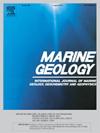Investigating the origin and dynamics of Carolina Bays
IF 2.6
3区 地球科学
Q2 GEOSCIENCES, MULTIDISCIPLINARY
引用次数: 0
Abstract
This study compiles a myriad of previously published and novel results from field-based and remote sensing investigations of Carolina Bays (shallow, circular to elliptic, sandy-rimmed, coastal plain depressions), aiming at identifying possible origin mechanisms as well as future research avenues. These investigations include neural network-based detection and morphometric analysis of over 20,000 Carolina Bays across the Atlantic Coastal Plain from digital elevation models; sedimentological investigations at Bays in Delaware, Virginia, North Carolina, and South Carolina; satellite-based surface water mapping of Bay lakes in North Carolina; a compilation of published geochronological data extracted from Carolina Bay sediments; collection of hydrodynamic data from a Carolina Bay pond; and geologic and geomorphic comparisons between Bays and similar depressions found in North America. This synthesis shows that Carolina Bays and similar depressions are widespread on unglaciated provinces composed of unconsolidated sediments, where wind was likely the main forcing mechanism which initially scoured out the depressions. Wave processes likely produced the Bays' characteristic round to ovate planform shape, with water-level fluctuations leaving behind sand rims as paleoshorelines. Holocene warming, increased humidity, and an increase in vegetation cover has induced more benign geomorphic conditions within Carolina Bays, during which finer sediment and organic matter has filled in these depressions. Modern observations of Carolina Bays and related features show little modern geomorphic activity. Geochronological data shows that Bays originated and underwent geomorphic modification from Marine Isotope Stage 5 to Marine Isotope Stage 1, coeval with the growth and decay of the Laurentide Ice Sheet, as well as with the development of nearby sand dunes. The available geochronological evidence is not compatible with an impact origin for the Bays, particularly one related to the Younger Dryas impact hypothesis or one related to Australasian tektites dating to 788 ka. The results of this synthesis should encourage future research into field-based, modeling, and synthetic investigations of Bays and similar depressions.
求助全文
约1分钟内获得全文
求助全文
来源期刊

Marine Geology
地学-地球科学综合
CiteScore
6.10
自引率
6.90%
发文量
175
审稿时长
21.9 weeks
期刊介绍:
Marine Geology is the premier international journal on marine geological processes in the broadest sense. We seek papers that are comprehensive, interdisciplinary and synthetic that will be lasting contributions to the field. Although most papers are based on regional studies, they must demonstrate new findings of international significance. We accept papers on subjects as diverse as seafloor hydrothermal systems, beach dynamics, early diagenesis, microbiological studies in sediments, palaeoclimate studies and geophysical studies of the seabed. We encourage papers that address emerging new fields, for example the influence of anthropogenic processes on coastal/marine geology and coastal/marine geoarchaeology. We insist that the papers are concerned with the marine realm and that they deal with geology: with rocks, sediments, and physical and chemical processes affecting them. Papers should address scientific hypotheses: highly descriptive data compilations or papers that deal only with marine management and risk assessment should be submitted to other journals. Papers on laboratory or modelling studies must demonstrate direct relevance to marine processes or deposits. The primary criteria for acceptance of papers is that the science is of high quality, novel, significant, and of broad international interest.
 求助内容:
求助内容: 应助结果提醒方式:
应助结果提醒方式:


